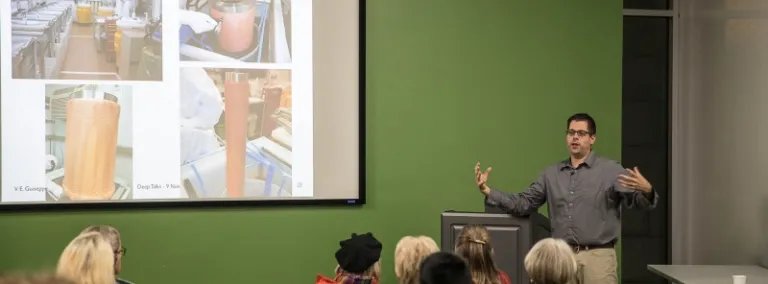Majorana researcher shares his thoughts on CERN’s LHCb discovery
While the focus of LHCb and MAJORANA could not be more different, the implications of their discoveries share a common goal.
Last month, CERN’s Large Hadron Collider beauty experiment (LHCb) collaboration discovered a new flavor of matter-antimatter asymmetry. The collaboration witnessed, for the first time, a phenomenon called CP violation in the decays of a particle known as a D0 meson. Put simply, this specific particle and its antiparticle have now been proven to act in a strangely dissimilar way.
The discovery further informs the matter-antimatter imbalance in the early universe. When the universe first formed, it had equal parts of matter and antimatter. According to what we know about these equal-yet-opposite forms, matter and antimatter should have instantaneously annihilated each other, leaving nothing but pure energy. Somewhere along the line, however, matter triumphed, and planets, stars, and, eventually, humans came into existence. Researchers with LHCb are seeking to understand this primeval asymmetry in order to grasp why matter won and, furthermore, why anything exists at all.
Sound familiar?
It should. The question of the matter-antimatter asymmetry is the same problem researchers with the Majorana Demonstrator (Majorana) are hoping to answer. Housed on the 4850 Level of Sanford Underground Research Facility (Sanford Lab), Majorana is a first step in the collaboration’s rare event search. Their search focuses on neutrinos, and whether neutrinos might be a long-sought answer to the matter-antimatter asymmetry problem.
“While the focus of the LHCb experiment and that of the Majorana experiment could not be more different, the implications of their discoveries share a common goal: understanding the matter-antimatter imbalance of the universe,” said Dr. Vincente Guiseppe. “The mysterious existence of humans and all the stars and planets in the universe after the Big Bang is a driving motivation for both of our experiments.” Guiseppe is the co-spokesperson for the Majorana Demonstrator collaboration and an assistant professor of physics and astronomy at the University of South Carolina.
So, what’s the difference?
In the case of LHCb, the matter-antimatter imbalance is theorized to be a result of a CP violation, meaning that the behavior of a particle is different than that of the mirror-image of its antimatter partner. Researchers have already witnessed this phenomena in two other particles (neutral mesons K and B). The recent result with D0 meson gives further proof of this CP violation.
According to CERN, however, even with this new result, the rate of these CP violation interactions is far too small to account for the present-day matter–antimatter asymmetry.
“In the case of unraveling the matter-antimatter imbalance of the universe, many experimental tests are required to explore the full scope of the question and to provide a unified theory of the particles that define matter in nature,” said Guiseppe.
Two such experiments studying different aspects of the matter-antimatter imbalance are Majorana and the next-generation LEGEND experiment (Large Enriched Germanium Experiment for Neutrinoless ββ Decay). These experiments zero in on neutrinos. Neutrinos have been theorized to be Majorana particles, particles that can act as both matter and antimatter. Instead of studying particles that act differently from the mirror-image of their antiparticles, such as D0 mesons, Majorana and LEGEND want to know if neutrinos can play both parts, doubling as their very own antiparticles.
To determine if neutrinos are Majorana particles, researchers are looking for a rare form of radioactive decay called neutrinoless double-beta decay. This incredibly subtle reaction, if observed, could indicate that neutrinos are partially responsible for matter-antimatter asymmetry.
“Experiments like LHCb and Majorana Demonstrator are much like pieces of a jigsaw puzzle,” Guiseppe explained. “Sometimes, the discoveries of two collaborations fit together perfectly, like two adjacent pieces of a jigsaw puzzle. In other cases, the two pieces may belong to the same puzzle, but fill in opposite ends. In both scenarios, though, the results equally help solve the full puzzle.”
Discovery informs discovery
This new LHCb discovery has little direct impact on the goals of Majorana and LEGEND, but it does reinforce the global motivation to search for additional particles that exhibit a CP violation. While the LHCb result applies to one class of particles demonstrating a CP violation, there remains another class in which such imbalance has not been observed. This is where neutrino research enters the scene.
“Should neutrinos exhibit a similar imbalance, it would most likely be observed by next-generation neutrino oscillation experiments such as the Deep Underground Neutrino Experiment (DUNE),” said Guiseppe. “If the neutrino is a Majorana particle (and thus acts as its own antiparticle), then there is yet another class of CP violation possible. This would open an additional opportunity to explore the neutrino’s role in the matter and antimatter imbalance.”
The focus of Majorana and other neutrinoless double-beta decay experiments is to answer the preceding question: is the neutrino is its own antiparticle? If researchers can shed light on the role neutrinos may play in tilting the balance between matter and antimatter, then the case for CP violation’s role would become even more convincing.
“In a sense, all experiments of physics help reinforce the common goal of explaining the natural world we see,” said Guiseppe. “Some experiments contradict or provide tension with others, while some validate or strengthen previous findings. But together, that is how science moves forward.”
As discoveries are made daily by the global particle physics community, each discovery informs other research. By compiling these small discoveries, physicists can begin forming a larger, more complete understanding of the universe.
